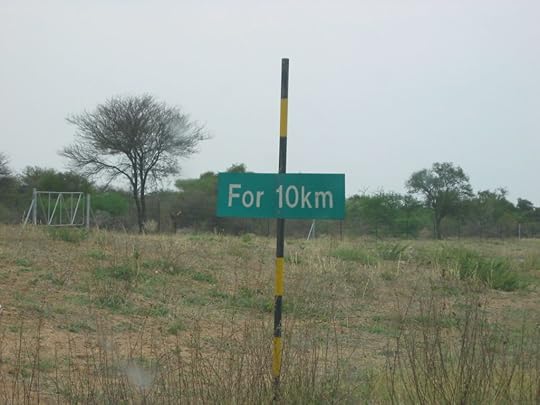Clea Simon's Blog, page 23
March 10, 2020
“The Mirror and the Light” review
Hi folks – I’d love you all to support the Boston Globe, where this review ran on Sunday. If you don’t pay, journalists can’t do their jobs. But, I also want you to read about this stunning book. And so, a few days late. here’s my review.
BOOK REVIEW
Hilary Mantel’s Cromwell comes full circle
A trilogy, and a man, reach a fitting end
By Clea Simon Globe Correspondent,Updated March 5, 2020, 7:00 p.m.
 Hilary MantelJOHN HAYNES
Hilary MantelJOHN HAYNESAny book that begins with a beheading is off to bang-up start, and “The Mirror and the Light,” Hilary Mantel’s brilliant new novel, opens with a world on edge. England in 1536 has theoretically been at peace for 40 years, but that peace is not an easy one. Unrest, stoked by the break with the Catholic Church two years earlier, is fueling revolt within, while the constant machinations of the country’s European rivals — France and the Holy Roman Empire — threaten without, especially as England lacks a clear line of succession.
At the center of all this, of course, is King Henry VIII, the Tudor monarch who has consolidated secular and religious power even as he lacks an heir. But just behind him stands a shadowy figure: Thomas Cromwell, the blacksmith’s boy-turned-royal councilor. As the final book of this great trilogy opens, Cromwell has risen from adviser to the late Cardinal Wolsey to principal secretary to the king, with higher still to go. It is he who poses the book’s central question, “If you cannot speak truth at a beheading, when can you speak it?” And it is Cromwell who, in the course of this stunning work, must uncover that truth, both about his world and himself.
Cromwell, whose rise Mantel explored in her Booker winners “Wolf Hall” (2009) and “Bring Up the Bodies” (2012), is a complicated figure. Before the British novelist turned her focus to him, the royal councilor was typically scorned as the “vile blood” Machiavellian adversary to the noble and scholarly Thomas More — a transactional politician who helped Ann Boleyn to the throne and, as this new book begins, to the scaffold. Mantel takes what is known of Cromwell — his meteoric rise, his autodidactic scholarship, his reformist tendencies — and weaves them into a masterful portrait of a man at mid-life, facing up to his past.Get The Weekender in your inboxThe Globe’s top picks for what to see and do each weekend, in Boston and beyond.Sign Up
Coming to terms with such a conflicted character is not easy. Cromwell’s interchangeable names — Cremuel to the French (as he was to Boleyn), Cremuello to the Italians, and Crumb to the king and his friends — hint at his many facets as well as his far-flung travels. To the reader, he is simply the narrator — once again, the close third-person “he” who speaks, raising (or rescuing) his friends and dissolving Catholic abbeys to enrich Henry (or himself).
It is Henry to whom the title refers, praised by Cromwell as “The mirror and the light of other kings.” Even for the cynical Cromwell, this isn’t pure flattery. “Our monarch wore white. Head to toe he shone. Like a mirror. Like a light,” he observes.
But this image contains seemingly opposing functions, and repetition reveals its dual faces. Cromwell understands the transfiguration of coronation as “a burst of light,” noting that if it is divine, it is also short-lived, and when Henry is maligned as “Lucifer” his self-educated councilor silently translates from the Greek: “Day star … bringer of light.” The sword that beheads Boleyn is inscribed with one version — “Speculum justitiae,” mirror of justice — and another appears as the now-wealthy Cromwell regards his “silver plate, reflecting himself to himself: the mirror and the light of all councillors that are in Christendom.”
Increasingly, however, Cromwell’s true guiding light is his illegal Protestant faith. When William Tyndale, who dared to translate the Bible into English, is martyred, his secret ally tells himself he “has put on the armour of light.”
Tyndale’s execution is one of several that trigger the royal councilor’s personal crisis. Now in his 50s, Cromwell finds “the brute moral deformation” he has forced on himself has come back to haunt him. As Henry becomes more despotic over the book’s four-year duration, conflict is inevitable. “I must restrain my cannibal king,” his councilor vows.
Does he have such power? As Cromwell is named Lord Privy Seal and then Earl of Essex, he struggles to shape political reality with his private beliefs. “Can you make a new England?” he asks. “You can write on England,” he concludes, “but what was written before keeps showing through, inscribed on the rocks and carried on floodwater, surfacing from deep cold wells.”
He may as well be speaking of himself. “The higher you rise,” the newly elevated Cromwell is told, “the more you mention the low place you come from.” What he isn’t sharing is the full scope of his father’s abuse or his own early savagery, memories that force him to confront the painful contradictions of his life.
“It is nowhere recorded that the rewards of public office include a quiet mind,” he muses, “aware of the shadow of his hand as it moves across the paper, his own inconcealable fist.”
For violence is inescapable. From that opening sentence — “Once the queen’s head is severed, he walks away” — axes and the shadow of death are everywhere. If that sounds grim, especially in a work that tops 750 pages, know that throughout, Mantel revels in witty wordplay and imagery. Flowers, for example, pop up as marigolds embroidered in support of the Catholic Princess Mary or pansies for the traitor Reginald Pole, even as London blooms as the “flower of cities all.”
Mantel’s language can be disarmingly contemporary — “suck on that, Mendoza” — or arcane, as terms like “dottypoll” (silly woman), “megrim” (headache), or “mouldwarp” add period savor that’s usually clear in context. That last — an archaic word for a mole — merits some research, as Henry is referred to as the Mouldwarp King, a legendary bestial monster, during the peasant revolution known as the Pilgrimage of Grace, and is further refracted, four pages later, when a plain old mole is imagined dispatched “with a shovel.” Such sly humor not only illustrates its protagonist’s erudition, it serves to leaven the novel’s weightiest subject: not the rule of a country or, even, faith, but the reckoning of a man with himself.
“When I was a young man,” Cromwell recalls, “I needed all my strength. Pity was a luxury I might one day afford, like fine white bread or a book … a beechwood fire; a safe hand to light it.” Before, he does not have to say, the darkness falls.
THE MIRROR AND THE LIGHT
By Hilary Mantel
Henry Holt, 764 pp., $30
Clea Simon’s most recent novel is “ An Incantation of Cats .” She can be reached at www.cleasimon.com .
March 6, 2020
The Mouldwarp King
You know how Alice gets lost down the rabbit hole? Well, friends, last week, I went down my own particular rabbit hole. I had the honor and the privilege of reviewing Hilary Mantel’s stunning new novel, The Mirror and the Light (more on that later). But to do that on deadline meant reading (and analyzing and absorbing and then writing about) 764 pages in less than a week. I love Mantel – and was amazed by this book – but I can tell you that was still difficult. Not being able to read the Sunday papers was a particular hardship.
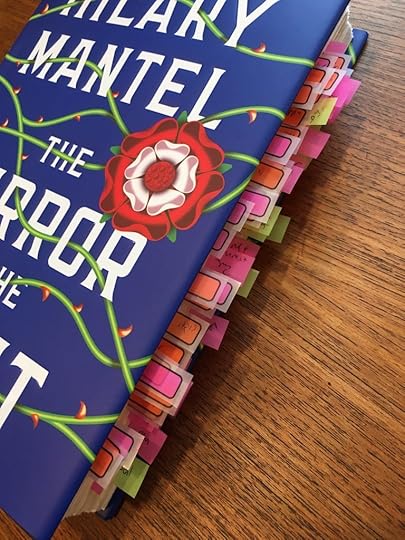 How I roll.
How I roll.You’d think that with an assignment like that, I’d just straight-out read. But with a book as rich as this one, there are too many distractions. I thought I understood “dotty poll” (p. 100) in context, but did I have it right? What about “megrim” (p. 473) (which, yes, is a precursor of “migraine”)? But what really tripped me up was a reference to the “mouldwarp” – and the “Mouldwarp King” (on pages 327 and 438) Huh? That led me from a Google search to essays on the Pilgrimage of Faith, a mass protest of Henry VIII’s disconnect from the Catholic Church (among other things). A few hours were lost down there… but so much more was found.
Therefore, I am taking the liberty of sharing these excerpts on “The Mouldwarp King” from the Invisible Works UK blog. (You can see my review in this Sunday’s Boston Globe or here.)
Guest post: Martyn Hudson
Like badgers in channels of hypocausts devoid of fire,
The Mouldwarps scatter the cairns of our mothers,
And the bogs hold our fathers pinned to wicker.[1]
The mole is an ‘earth-thrower’ – a mouldywarp, molywarppe, moudiwarp, mouldwarp, moldwarp. The collision between the mole and folklore has often been to the detriment of the mole. In lore a severed paw of the mole, if worn in a bag around the neck could cure toothache and scrofula – the ‘King’s Evil’. Moles won’t touch earth stained by blood, if moles dig deep a dark winter is coming, moles are blind. The blind or hardly-seeing mole is a recurrent motif in folklore and literature but although the mole does have anatomical regression of its eyes due to its burrowing below ground they can see. Their lives are about the conquest and consumption of earthworms in the dark.
But the mouldwarp is also a recurrent feature of political prophecies throughout the medieval period and up to our own. …
… the local folklore of the Mouldwarp, linked as it was to both witches and prophecy, would move beyond these moors and dales to affect the course of the realm above – leading many of the proponents of the prophecy themselves to the lands of the dead. The so-called Mouldwarp prophecies recurred time and time again (in their extant forms without an original source) in the medieval period as part of the Book of Merlin. They were used as coded assaults on kingship and certain specific kings like Henry IV but found their epitome during the Pilgrimage of Grace and the northern rebellion against Henry VIII. As A.G. Dickens has said – the Pilgrimage ‘was riddled with rumour, fable, folklore and prophecy, particularly by those prophecies concerning the rise and fall of kings which are traceable to the writings of Geoffrey of Monmouth and which had appeared in former occasions, for example in the days of Hotspur and Henry IV’.[10] The predominantly Catholic uprising used the Mouldwarp prophecies as its ideological ballast in its contest with Henry but the Mouldwarp motifs had previously been used by the Lollards and early protestant reformers.
Again, you can read more here: https://www.invisibleworks.co.uk/the-mouldwarp-king/
March 1, 2020
Five Questions with Nancy Bilyeau
I don’t know about you, but I love to escape into historical fiction. A good historical gives you a real sense of the place and the time but – being fiction – weaves a compelling story in as well. (Apologies to my historian friends, but true stories are seldom as neat or as well understood). What’s special about historical novelist Nancy Bilyeau is her ability to write so many periods – from Tudor England to early 20th Century Coney Island. I’m thrilled that she took the time to chat today.
How does a book start for you?
With an idea that causes a rush of excitement—“Could this be a novel?”—followed by a few days of both daydreaming and intense research. If after those few days I still feel the idea is novel-worthy, I write Chapter One, Page One.
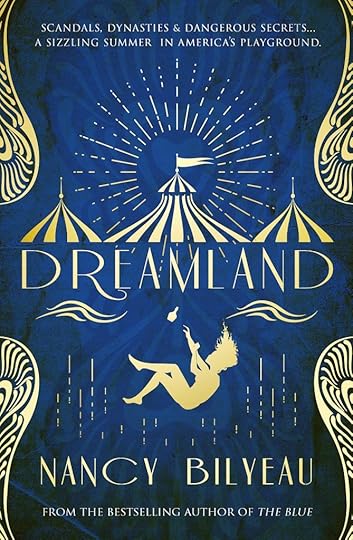
Who in your latest book has surprised you most – and why?
In my novel Dreamland, the main character is a rebellious heiress named Peggy. In the story, Peggy has a younger sister, Lydia, who starts out as very spoiled and conventional, but in the last one-third on the novel, to my own surprise, Lydia as a character grows emotionally and begins to challenge those who are suppressing her and stifling her.
When and/or where is your latest book set and is there a story behind that setting?
My novel is set in the summer of 1911, primarily in Coney Island. I discovered that at the turn of the last century there were three luxury hotels favored by the wealthy, gorgeous Edwardian buildings, on the Atlantic Ocean located about a mile from the booming amusement park, attracting the factory workers and immigrants of the city. I thought it would be interesting to make those two worlds collide.
What are you working on now?
A follow up to Dreamland with the same main character, whose life is based on the young Peggy Guggenheim.

Which question didn’t I ask you that I should have?
Whether I write to music. The answer is yes, in the last one-third of the story, I do. I love to listen to Beethoven or film scores by composers like Bernard Herrmann, Trevor Jones, or Hans Zimmer.
If you tell Nancy Bilyeau that reading one of her historical novels of suspense is like strapping yourself into a time machine, you’ll make her a very happy woman. She loves crafting immersive historical stories, whether it’s the Gilded Age of New York in Dreamland and The Ghost of Madison Avenue, the 18th-century European porcelain workshops in The Blue, or Henry VIII’s tumultuous England in The Crown, The Chalice, and The Tapestry.

In The Blue, Nancy drew on her own heritage as a Huguenot. She is a direct descendant of Pierre Billiou, a French Huguenot who immigrated to what was then New Amsterdam (later New York City) in 1661. Nancy’s ancestor, Isaac, was born on the boat crossing the Atlantic, the St. Jean de Baptiste. Pierre’s stone house still stands and is the third oldest house in New York State.
Nancy’s mind is always in past centuries but she currently lives with her husband and two children in Queens, NY. Her quest to cook the perfectly flavored pasta puttanesca is ongoing.
February 23, 2020
Five Questions with Gerald Coleman
Sitting on a panel next to Gerald Coleman is kind of like sitting next to royalty. The man makes worlds, people! Entire universes! The occasion was the recent Boskone conference, where we were literally talking about world-making, and how we do it. Since I came to this wonderful science fiction and fantasy convention by way of my paranormal mysteries (i.e., witch cats!), I was a bit at a disadvantage. I may imagine powers for my felines, but I basically write in the “real” world. That doesn’t stop me from reading outside my lane, however. And if you grew up on Tolkein or Harry Potter, well, you should take the next step and check out Gerald’s books – and all his worlds!
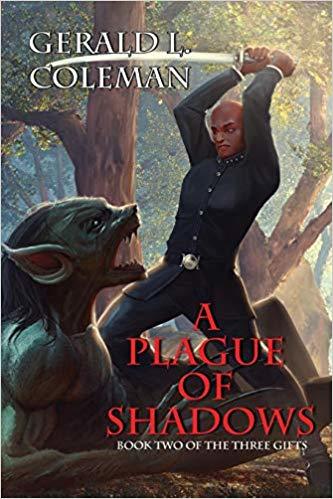
How does a story start for you?
It begins with an idea – a nugget, or a thought, or note jotted in my journal. If it’s for a shorty story with predetermined parameters then it begins with me reading over those and then letting my mind wander and play with it in the “background” or my subconscious. The way the mind works never ceases to amaze me – how it can chew on an idea without you really consciously knowing that it’s going on until it presents you with an idea like a gift.
Who in your latest book has surprised you?
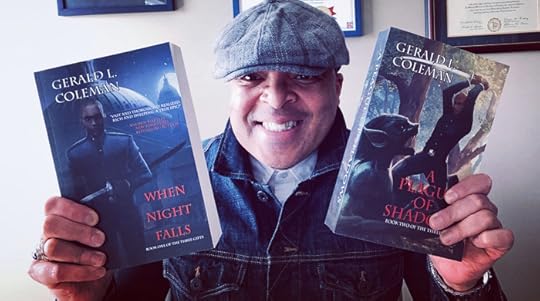
My most recent published novel is A Plague of Shadows, the second book in my epic fantasy series. I’m currently working on book three. I guess i’d say that it’s not one individual character, but how characters in a story can take on a life of their own in your imagination. And coupled with how your subconscious can chew on an idea
without your conscious input that can lead to some interesting directions in plot that you had not considered. Maybe it’s also the world of the itself. I love worldbuilding and sometimes it surprising how expansive and in-depth the world you’re creating can become, as if it too has a life of its own.
When or where is you latest book set and is there a story behind that setting?
The other project i’m currently writing is a scifi novel. It opens on a desolate planet in a nowhere corner of the galaxy. It’s influenced by Star Wars, Doctor Who, The Faded Sun series by C. J. Cherryh, Black Panther, and African history. It’s a reaction to history, the current state of inclusion and diversity in SF&F, particularly scifi, and plays with the tropes of the genre in a way that should be provocative and exciting.
What are you working on now?
As I mentioned above, I’m working on a scifi novel, the third book on my epic fantasy series, and two short stories. The first short story is for a dystopian anthology being published by Onyx Path Publishing and the second is for Broken Eye Books.
What question did I not ask that I should have?
Hmmm. I’ll say, why do I write what I write? I’ve been a science fiction and fantasy fan my entire life. It began with Scholastic in elementary school and purchasing books like Mrs. Frisby and the Rats of NIMH, followed soon after by Watership Down. After that it was comic books and SF&F novels. I read voraciously. But, it wasn’t long after I hit my teens that I began to realize that none of the characters looked like me. I wasn’t represented in either fantasy or science fiction. I soon knew that I wanted to write SF&F and I also always knew that I was going to write with POC, particularly black folks, at the center of my stories.
Gerald L. Coleman is a Philosopher, Theologian, Poet, and Scifi-Fantasy Author residing in Atlanta. Born in Lexington, he did his undergraduate work in Philosophy and English at the University of Kentucky. He followed that by completing a degree in Religious Studies, concluding with a Master’s degree in Theology at Trevecca in Nashville. His most recent poetry appears in, Pluck! The Journal of Affrilachian Arts & Culture, Drawn To Marvel: Poems From The Comic Books, Pine Mountain Sand & Gravel Vol. 18, Black Bone Anthology, the 10th Anniversary Issue of Diode Poetry Journal, and About Place Journal. His speculative fiction short stories appear in: The Science Fiction, Cyberfunk Anthology: The City, the Rococoa Anthology by Roaring Lion, the Urban Fantasy Anthology:Terminus, the 2019 JordanCon Anthology: You Want Stories?, Dark Universe: Bright Empire. He is the author of the Epic Fantasy novel saga The Three Gifts, which currently includes When Night Falls (Book One) and A Plague of Shadows (Book Two). He has been a Guest Author and Attending Professional at DragonCon, Boskone, Blacktasticon, JordanCon, Atlanta Science Fiction & Fantasy Expo, The Outer Dark Symposium, World Horror Con, and Imaginarium. He has recently joined the staff of WorldCon Dublin as its Programme Content Consultant, and Multiverse Con as its Director in programming for the Fantasy Track. He is a co-founder of the Affrilachian Poets and has released four collections of poetry entitled the road is long, falling to earth, microphone check, and Nappy Metaphysic. You can find him at GeraldLColeman.com.
February 21, 2020
Mystery Scene loves “Incantation”!
“Otherworldly fun,” says this review in Mystery Scene magazine. ” I couldn’t figure out which group provided the most fun: the clueless humans or the ever-so-sly cats.” Read the full review here (or below):

Clea Simon’s An Incantation of Cats: A Witch Cats of Cambridge Mystery is an otherworldly fun trip, in which the cat sisters—seal point Laurel, creamsicle Harriet, and calico Clara—have joined forces to help Becca, a witch detective and their “person,” solve Wiccan-related mysteries. They also try to rejuvenate Becca’s fading love life after she’s been dumped by her boyfriend. The cats are great fun, especially pushy Laurel, who thinks she knows everything. But it’s Clara who is actually the brains of the litter, partially because she has no trouble deciphering the websites Becca keeps logging on to for information. True, Clara can’t exactly read, but she’s a whiz at putting together the meanings of graphics and photos. Together, the three cats and their Wiccan person make a nifty team of Holmes-style detectives, although Becca isn’t always cognizant of the help she’s getting from her feline friends. This time out, a woman suspects an employee might be stealing from her, and a man may have been “helped” to die of a heart attack. Both cases turn out to be more complicated than they first appear, but the cats—led by the youngest but wisest Clara—eventually figure it out. As for me, I couldn’t figure out which group provided the most fun: the clueless humans or the ever-so-sly cats. – Betty Webb
BooksAn Incantation of Cats: A Witch Cats of Cambridge Mystery
by Clea Simon
Polis, January 2020, $26
February 16, 2020
Five Questions with Jeri Westerson
Jeri Westerson‘s imagination spans worlds – literally, in that this mistress of mystery writes everything from “Medieval Noir” to paranormal werewolves. Of course, in Jeri’s worlds, these wild imaginings make sense, whether she’s got series hero Crispin Guest on the hunt for a religious relic or a surfer dude dealing with a werewolf problem. I confess, I know Jeri through her medieval books – I love a believable, lived-in historical and what could be better than a disgraced knight as a sleuth? But after chatting with her, I’m ready to take on the paranormal, too. And you? What’s your favorite?
How does a book start for you?
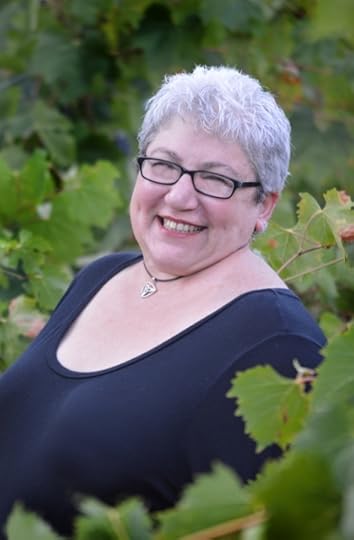
Sometimes, a stray idea. A bit of dialogue that appears out of nowhere. For the Crispin Guest Medieval Noir mysteries, it’s often with the murder or the religious relic that I want to use in the story. As I moved on in that series, the relic became less important and the murder and what it meant to the characters became more important.
With my paranormals, it’s the premise. A magical Booke that wreaks havoc by releasing creatures into the world. That was from Booke of the Hidden, and my latest is a spin-off from it, a guy with a werewolf problem who just wants to live his life as a surfer and a bit of a player, but must contend with his new life as a werewolf and forced to solve some murders along the way. That one is Moonrisers.
Who in your latest book has surprised you most – and why?
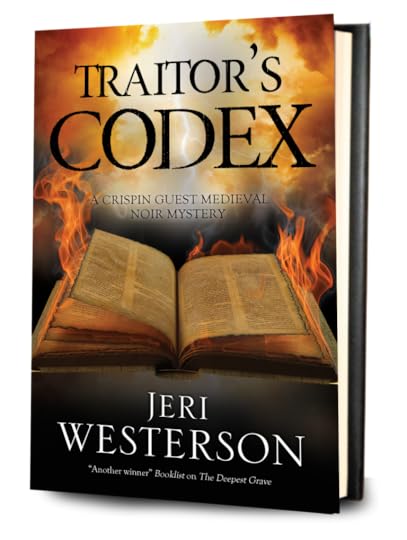
Crispin always surprises me. He’s gone through so many changes in the thirteen books (so far) of his series. I’ve often said that a series is like the longest ever novel, because you can take the time to really bring your characters through some life-changing experiences, where they can either grow or break…or sometimes a little of both.
When and/or where is your latest book set and is there a story behind that setting?
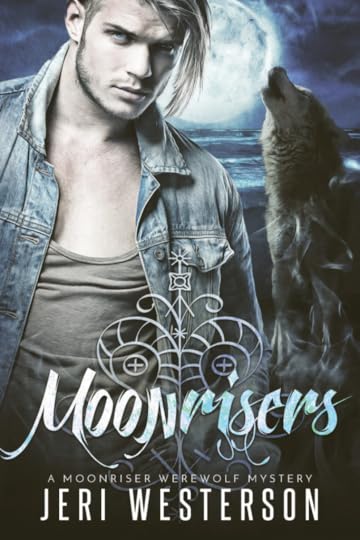
My latest is Moonrisers; A Werewolf Mystery, set in modern-day Huntington Beach. The main character, Jeff Chase, is a spin-off character from my first paranormal series, Booke of the Hidden. He was the boyfriend of the main character of THAT series, Kylie Strange, and he went to Maine where she’d moved to to win her back. In the course of the novels he gets bitten by a werewolf and his whole life changes. So in his series, he comes back home to Huntington Beach to resume his life as a surfer and tea and spice shop proprietor. I chose Huntington Beach because it’s a beach area in SoCal, an unlikely place to find supernatural activity, and I am familiar with the beaches in southern California. And since the book is in Jeff’s point-of-view, we get to experience “Surf City” as he does, and perhaps are just as surprised as he is to discover a werewolf pack that lives there, along with a Voodoo coven. So it makes for a lot of fun and situational humor.
What are you working on now?
The penultimate Crispin Guest novel, Spiteful Bones His series will come to an end with the book after this one, The Deadliest Sin. It’s a bittersweet moment for me. Crispin got me published and I have enjoyed his journey, but I always planned a last book just so the stories wouldn’t get stale or repetitive. I know I’ve read other series where I felt the author should have ended them sooner, that they went on a little too long. And I didn’t want that for Crispin. Besides, it’s time to write other things, mostly paranormal, which was a first love of mine way back in college, when I used to devour all manner of science fiction and fantasy. Some will also be mysteries, and there is even a crossover of medieval, mystery, and paranormal in the works.

I also have a steampunk/Neo-Victorian/Gaslamp series I’m working on. I released the first of the Enchanter Chronicles with The Daemon Device last year. My protagonist is a magician of Jewish/Gypsy blood who is ashamed of that heritage but uses his research into the Kabbalah to summon Jewish daemons in order to perform true magic. He gets involved in solving some mysteries for Scotland Yard and stopping villains from opening the gates of Gehenna in this three-book series. In fact, I need to work on and release this year the second in the series, The Clockwork Gypsy, so that will also keep me busy.
Los Angeles native JERI WESTERSON is the author of thirteen Crispin Guest Medieval Noir Mystery novels, a series nominated for thirteen national awards from the Agatha to the Shamus. Her fifth novel BLOOD LANCE was named one of the Ten Hot Crime Novels for Colder Days by Kirkus Reviews, and her sixth, SHADOW OF THE ALCHEMIST, was named Best of 2013 by Suspense Magazine. Library Journal has twice honored her series with starred reviews: “Westerson skillfully lulls her sleuth and the reader into a sense of ‘I know what is going on,’ then zings them with the truth. Absolutely first-class; highly recommended,” while Boston Globe calls her detective “A medieval Sam Spade, a tough guy who operates according to his own moral compass.” The Historical Novel Society has twice made her books Editor’s Choice and thriller author John Lescroart calls her books, “Creative and enthralling… Medieval history combined with modern suspense.” For BOOKE OF THE HIDDEN, her urban fantasy series, Publishers Weekly said, “Readers sad about the ending of Charlaine Harris’s MIDNIGHT, TEXAS trilogy will find some consolation in Moody Bog.” Jeri recently released the first in her historical fantasy/steampunk Enchanter Chronicles trilogy, THE DAEMON DEVICE. She is also awaiting the upcoming release of MOONRISERS, her first in a werewolf mystery series. She also has short stories in several mystery anthologies, including Shaken: Stories for Japan (for the 2011 Earthquake Relief Fund). Jeri was also featured on three local NPR shows, “My Awesome Empire”, “Lifestyles with Lillian Vasquez”, and “KVCR-Arts”. She has served two terms as president of the Southern California Chapter of Mystery Writers of America, twice president of the Orange County Chapter of Sisters in Crime, and one term as vice president and California Crime Writers Conference co-chair for the Los Angeles Chapter of Sisters in Crime. See more about Jeri at JeriWesterson.com
February 13, 2020
How It Happened
The International Thriller Writers association runs a great series, called “How It Happened,” in its The Big Thrill, letting established authors share their pathway to publication. These are usually great fun, if for no other reason than to learn about all the troubles most of us ran into along the way. This week, I got to share mine.
How It Happened by Clea Simon
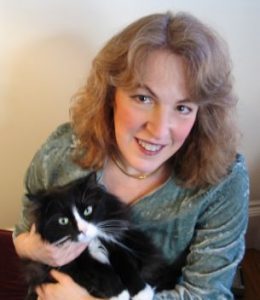
Until her death, my mom kept the evidence. The yellow paper, with its green lines covered front and back with my awkward pencil scrawl. First grade, maybe, or second, and we’d been told to write the story of the frog prince. I remember the picture that served as a prompt. Green frog, yellow crown. Lily pad. All well and good, except to me the familiar fairy tale was old hat by that point, and so I filled both sides of the paper, laboriously formed letter by laborious letter, telling of how the prince failed in his quest to reach the end of the world and thus had to make peace with being a frog. I had the fiction bug. That story wanted to be written.
Along the way, it was nearly crushed out of me. Creative writing classes. The reality of earning a living. Fast forward a few decades, and I was a journalist. After a decade of that, I started writing nonfiction books, but the underlying insecurity was the same: Nobody was paying for my writing. That existed only to convey the information I had found. My research.
I was still reading, of course. That’s what we do, and I was enough of a crime fiction junkie to become friends with , who was then-owner of a wonderful indie bookstore in Cambridge, Mass., called, fittingly enough, Kate’s Mystery Books. Kate’s was the kind of place that had signed first editions but would also let you sell back what you’d read for credit. Her “used” shelves gave me my genre education. Of course, I was a regular at her holiday parties – mad open houses, where local greats like Robert Parker and Linda Barnes would crowd in besides fledgling authors and fans, often spilling onto the store’s front yard, even in the worst New England winter weather. And as the 2002 party rolled around, Kate asked if I wanted to sign my latest nonfiction book at her party. That was The Feline Mystique: On the Mysterious Connection Between Women and Cats, a collection of lore and my usual research, with some personal stories and interviews woven in. Despite that word in its subtitle, it was not, by any stretch, a mystery.
I was flattered, but I pushed back. “It’s not a mystery, Kate. It’s not even fiction.”
“Believe it or not, Clea,” she responded. “There’s a huge overlap between women who love cats and mystery readers.”
Who was I to argue? She got a shipment of the books, and I attended as an author for the first time. As I recall, the party was so crowded that year that I never made it far enough into the shop to stand next to my book. It didn’t matter, a good time was had by all. Much wine was consumed as well. As the party wound down, I stayed to help clean up, grateful and a bit stunned. There may have been more wine involved.
At the end of the night, Kate turned to me. “Clea,” she said. “You should write a mystery.” She was giving me permission, her words a magic spell that revealed my true self, warts and all. And the very next day I started what would become my first mystery, Mew is for Murder. What followed was the usual saga of revising and submitting and rejections and resubmitting (Poisoned Pen published it in 2005). But by that point, I wasn’t going to stop. Like that frog, I’ve accepted who I am, crown, lily pad, and all. Thanks, Kate.
The author of more than two dozen cozy/amateur sleuth mysteries featuring cats, three nonfiction books, and one punk rock urban noir, World Enough (Severn House) (a Mass Book Awards “must read”), Clea Simon likes to keep busy. The Boston Globe best-selling author’s latest is An Incantation of Cats, the second “Witch Cats of Cambridge” cozy mystery series from Polis Books. Clea lives in Somerville, Massachusetts, with her husband and one (1) cat. She can be reached at www.cleasimon.com and on Twitter @Clea_Simon
To learn more about Clea Simon’s newest novel, click on the cover below:
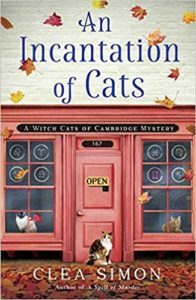
February 12, 2020
A dark thriller…
No, not a crime novel, but thrilling nonetheless! I absolutely loved Daniel Kehlmann’s “Tyll.” Here’s my review, which ran in Sunday’s Boston Globe.
BOOK REVIEW
In Daniel Kehlmann’s darkly brilliant ‘Tyll,’ a fool worth following
By Clea Simon Globe Correspondent,Updated February 6, 2020, 8:00 p.m.
 STOCK.ADOBE.COM
STOCK.ADOBE.COMA jester is an outsider — the motley-clad fool who can poke fun at the mighty and speak truth to power. His role in history is to amuse, of course, but also to expose flaws in those deemed to be above ordinary censure. It’s a tightrope walk: One slip and one’s life is forfeit. At his best, as with Shakespeare’s various fools, he serves an almost divine function, leveling humanity.
Tyll Ulenspiegel, the mercurial protagonist of German author Daniel Kehlmann’s darkly brilliant new novel, fulfills all these roles — reflecting the vanity and folly of those in power, while also serving as a mirror of the times. In Kehlmann’s hands, Tyll, based on the German folk hero better known here as Till Eulenspiegel, also has a compelling personal story, one he alternately reveals in jest and dances away from.
In German folklore, Tyll is a joker whose tricks often highlight people’s worst traits. But while the classic figure probably dates to the 1300s, Kehlmann puts Tyll in the middle of the Thirty Years’ War (1618–48), when the essentially feudal society was being ripped to shreds in ways that would help shape modern Europe.
Reminiscent of Marguerite Yourcenar’s “The Abyss,” which is set slightly earlier, “Tyll” is merciless, following its protagonist through a war-torn continent terrorized by lawless mercenaries and equally bloodthirsty religious zealots. It’s a world where the possession of a book can result in execution for heresy, but one quick-witted boy just might be able to find his balance between deadly extremes.
Like one of Tyll’s japes, the core story takes some unraveling. The jester is first introduced as a traveling entertainer, a stranger whose arrival excites a village. A master of his art, he trades in jokes and contradictions. “I’m Tyll,” he tells a local girl. “My sister over there is Nele. She’s not my sister.”
As he performs, the girl is mesmerized. She’s not alone. The visitor wields a strange kind of power over his audience, one that ultimately reveals the foolishness of blind obedience. The option, he suggests to the girl, is freedom.
“Think of the old saying,” Tyll says, inviting her to join his small band with what will become a recurring motif. “You can find something better than death everywhere.”
The choice is so difficult as to be almost unimaginable. This is a static society, where assigned roles have long meant stability and protection. As Nele, Tyll’s traveling companion, explains: “Girls don’t go to other places. They stay where they were born; so it has always been.”
Only, in Tyll’s world, war and change are overturning those certainties, wreaking havoc with the norms. From that village girl to the Queen of Bohemia, none are immune, although all who come into contact with the quicksilver Tyll have at least a moment of grace — a few pages of narrative in which they can ponder their choices and their fate. It’s an episodic and nonlinear approach, and Ross Benjamin’s translation gives a clarity to the individual voices that render their stories — tragedies, for the most part — profoundly humane.
Tyll’s own story is interspersed throughout, his narrative weaving together all the tales. The son of an intellectually curious but incautious miller, as a boy Tyll survives a near-death experience when a bully throws him into the mill stream and he passes under the mill’s wheel. His mother sees this as a blessing: “You’ve now been baptized twice.” But the device also has resonance as the symbolic “wheel of fortune,” a pagan allegory that gained popularity in medieval morality plays.
Tyll soon learns about the wheel’s turns and that religion is not his ally. He becomes the ultimate escape artist — on the road, on the wire, joking and telling stories without a care in the world. Except that this is a world full of cares, and at the core of Tyll’s story is a situation he couldn’t slip away from.
By the time we learn of this subsequent trauma, we are deep in the turning of the wheel. A king is deposed so quickly that a traveling ballad singer is forced to hurriedly rewrite his verses. A fat count accepts an assignment that will threaten his life — and make his fame. Along the way Tyll pops in and out, both up and down, as we find him buried in a mine or entertaining at court. On a rare occasion he meets a peer, such as that queen, who is using illusion in her own way to assert her rights. But even as he reflects back the humanity of all who encounter him, Tyll stands apart.
“I’m made of air,” he says at his lowest moment. “Nothing will happen to me. … All this is still fortunate.” For Tyll understands fortune, and how its wheel turns.
TYLL
By Daniel Kehlmann, translated by Ross Benjamin
Pantheon, 351 pp., $26.95
Clea Simon’s most recent novel is “ An Incantation of Cats .” She can be reached at www.cleasimon.com .
February 9, 2020
Five Questions with L.J. Sellers
When a best-selling author like L.J. Sellers comes out with a new book with established series characters, readers know to expect a good time. But as her her 15th Jackson & Dallas thriller – The Black Pill – is about to be released, they should also know that she’s going to surprise them! And so, on the eve of her new book, I’m thrilled to have her here, talking about the new book, her process, and her other projects.
How does a book start for you?
The first seeds of a story are planted when I see a news story about a crime that intrigues me. Especially if it’s unusual or seems unsolvable. Concurrently, I almost always have a social issue, or fear, that I’m feeling passionate about. So I start bouncing those two ideas off of each other a plot begins to gel.
Who in your latest book has surprised you most – and why?
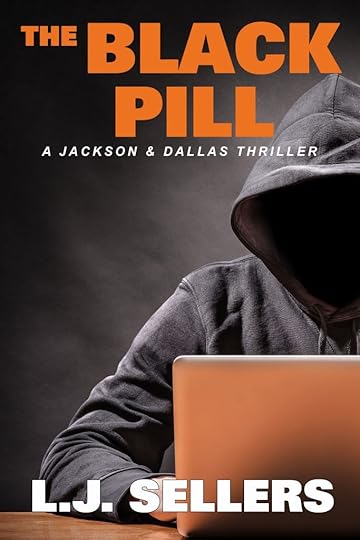
The Black Pill, which releases tomorrow, features two of my series characters: Detective Jackson and Agent Dallas. They both surprised me with how they felt about their current love interests and ended up doing the opposite of what readers might expect. For a moment, that made me look deeply at my own relationship to see if I had undercurrents that I wasn’t acknowledging. But no, it was just the right timing for my fictional characters.
When and/or where is your latest book set and is there a story behind that setting?
The Black Pill has two settings, one in Eugene, OR, where all Jackson’s stories are based, and the second in Vancouver, WA, where Agent Dallas is assigned to travel for an undercover investigation. I often visit Vancouver because my grandchildren live there. And yes, there’s a story behind those grandkids and how they came to live there. Here’s the short version:
My husband and I traveled to Costa Rica to rescue them from a dangerous cult—and mentally ill mother—and ended up running and hiding in the jungle from men with guns. But we prevailed and managed to get the kids home to the states and to their extended biological family, most of whom live in Vancouver.
What are you working on now?

I’m writing the true, detailed story of that adventure. I’ve already crafted a movie script about it, and it’s currently being considered by several production companies.
Which question didn’t I ask you that I should have?
You might have asked: What’s the connection between all these elements?In my new release, The Black Pill, the character backgrounds are based on the horrific conditions those kids were living in. The other theme of the story is the online world of incels (involuntary celibates) and their hatred of, and violence toward, women. As I mentioned earlier, that’s how stories start for me. Two intense crimes/issues that I can’t stop thinking about will suddenly come together. In this case, the characters are who I feared my grandsons would become if we had not intervened and they had grown up uneducated and uncared for.
L.J. Sellers writes the bestselling Detective Jackson mystery/thriller series—a four-time winner of the Readers Favorite Awards. She also pens the high-octane Agent Dallas series, The Extractor books, and provocative standalone thrillers. Her 23 novels have been highly praised by reviewers, and she’s one of the highest-rated crime fiction authors on Amazon.
L.J. resides in Eugene, Oregon where many of her novels are set, and she’s an award-winning journalist who earned the Grand Neal. When not plotting murders, she enjoys standup comedy, cycling, and zip-lining. She’s also been known to jump out of airplanes.
February 2, 2020
Five Questions with Michael Stanley
I’d like to say I met the writing team of Michael Sears and Stanley Trollip on safari. In truth, we were driving around Pittsburgh, looking for a wonderful (now defunct) author event sponsored by the (still there!) Mystery Lovers Bookshop in Oakmont, PA. I had long been a fan of “Michael Stanley,” though, and their leisure-loving (but astute) Detective Kubu. How nice to reconnect at a a party given by the team’s new publisher, Sourcebooks/Poisoned Pen, then – and to catch up on Kubu, too!
How does a book start for you?
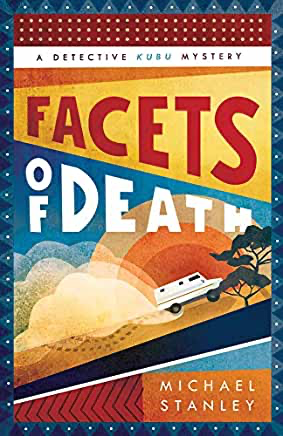
Usually one of us gets an idea that intrigues the other. Then we get together and brainstorm, producing a very rough outline of how the book will start and where it will head. Although we live in different cities, we usually try to get together to do this, maybe in Botswana or on a book tour. After that one of us will kick off with a first draft of the first couple of chapters and we’ll see where it goes from there.
Who in your latest book has surprised you most – and why?
Oddly, it was our protagonist, Detective Kubu. Kubu means hippopotamus in the local language, and that describes him well. Very large, overweight, but also dangerous if he’s on a case. The new book, Facets of Death, is about Kubu when he’s a new detective, and we found out several things we didn’t know about him. He was smart all right, but also had a lot to learn both about detective work and about dealing with people—especially women. His character was rather different from the more mature and senior detective of the later books. Some of that was unexpected. We know him better now. And we still like him a lot!
 Michael Sears
Michael SearsWhen and/or where is your latest book set and is there a story behind that setting?
Facets of Death is a prequel, set around twenty years ago. When we wrote our first novel, Kubu wasn’t supposed to be the protagonist. He was supposed to be a minor character—a policeman sent out to investigate a murder. He climbed into his car with sandwiches and cassette tapes of his favourite operas, and headed out. It’s a long drive to where the body had been found in the middle of the Kalahari Desert, so he had plenty of time to think. One thing he mused about was how a Bushman school friend had shown him how to see things in the desert that were invisible to most people. That was the spark that made Kubu want to become a detective. By the time he reached the scene of the crime, he’d taken over the story and demanded to be the protagonist. We were both very surprised!
 Stan Trollip
Stan TrollipAs Kubu developed over the series, we learned more about his school and family life, but really nothing about how he became Botswana’s ace detective. That was not only a gap in his background, but also in his character. So we decided to write that story, starting with his first day at the Criminal Investigation Department.
What are you working on now?
Our publisher is delighted with the prequel, and is keen to develop it over a few books as almost a new series. At the moment, we have ideas for another two books around the young Kubu.
Which question didn’t I ask you that I should have?
What are two white men in South Africa doing writing about a black detective in Botswana?
We know Botswana well in various ways and love the country and the people there. We think we know the culture well enough to represent it realistically. And it’s useful setting our books outside South Africa, so we’re not always having to deal with the aftermath of apartheid. That way we can explore contemporary issues important to the broader region—issues like blood diamonds, the plight of the San (Bushman) peoples, and the growing Chinese influence in southern Africa. In Facets of Death it’s the concept of a huge diamond heist that could shake the Botswana economy.


Michael Sears and Stanley Trollip write under the name Michael Stanley. Their award-winning mystery series, featuring Detective Kubu, is set in Botswana, a fascinating country with magnificent conservation areas and varied peoples. The latest book in the series is a prequel, titled Facets of Death. It starts the first day Kubu joins the Botswana CID, and he’s immediately thrown into solving a violent heist of rough diamonds from Jwaneng—the world’s richest diamond mine.
Their latest thriller Shoot the Bastards introduces Minnesotan environmental journalist Crystal Nguyen. Set mainly in South Africa, it has as backstory the vicious trade in rhino horn.
Michael has lived in South Africa, Kenya, Australia and the US. He now lives in Knysna on the Cape south coast of South Africa. Stanley splits his time between Minneapolis and Cape Town.
